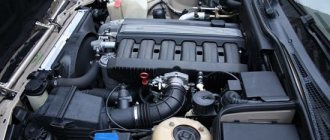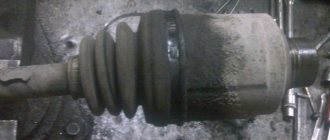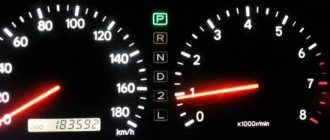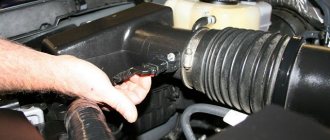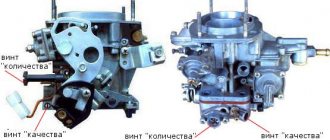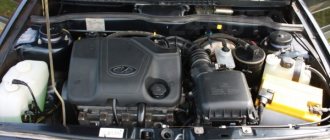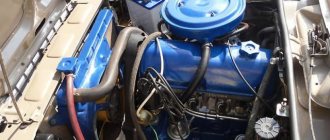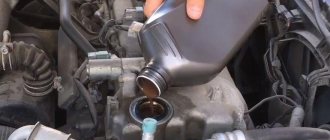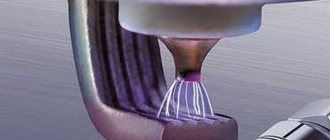The situation when the engine stalls at idle occurs quite often. This phenomenon can occur both on cars with high mileage and on new cars. It is worth noting that the process of starting a cold engine with a starter can be either initially difficult or proceed absolutely normally.
In other words, the engine may run fine or hot, but then starts to stall at idle. Also in a number of cases, it appears that when you press the gas pedal and increase the speed, the engine begins to operate stably. There are several main reasons why the engine “does not hold” idle speed, troits and shakes. Next, we will look at why the car stalls at idle or runs very unevenly after starting “cold”, during transition modes “hot”, etc.
Gasoline engine does not idle
Let's start with the fact that this malfunction indicates two possible causes: failure of individual mechanisms, components or sensors, as well as severe contamination of certain elements. In both the first and second cases, it is necessary to carry out a diagnosis. The engine on injection and carburetor cars can most often stall at idle in the following cases:
- the idle air regulator (IAC) has failed;
- the throttle valve is dirty or malfunctioning;
- the carburetor channels are clogged or the fuel jet XX is dirty;
- the performance of injection nozzles is reduced or impaired;
- the mesh of the electric/mechanical fuel pump is clogged, malfunctions of this unit have occurred;
- there was a decrease in the throughput of the fuel filter;
- the air filter is dirty, air leaks at the inlet;
- failure of the mass air flow sensor, throttle position sensor, etc.;
- clogging of the engine crankcase ventilation system;
We also recommend reading the article on how to replace the mesh filter on the fuel pump yourself. From this article you will learn about methods for removing the fuel pump to replace the mesh, and also find useful tips for successfully implementing this process.
If the car immediately stalls or the speed fluctuates noticeably after the starter is turned off, then you should pay attention to the throttle assembly. It is possible that the valve may become clogged or the mechanism may become jammed. This malfunction, especially severe contamination, occurs as a result of prolonged driving on low-quality fuel, as well as untimely replacement of the air filter.
In this case, the throttle valve needs to be cleaned. To clean the throttle, use a regular “carbicleaner” (a product for cleaning carburetors), and you also need to blow out the valve using compressed air from the compressor. If these steps do not help, then you will need to evaluate the condition of the oil trap. This element is an integral part of the engine crankcase ventilation system. A dirty oil trap causes crankcase gases to “choke” the engine, idle speed floats and the internal combustion engine stalls.
Now let's look at a situation where the car starts normally, but then starts to stall (constantly or with a certain frequency). A similar situation often occurs on fuel-injected cars that have an electronic engine control system (ECM).
The cause of unstable engine operation may be electronic sensors, as well as the idle air control (IAC). You should check the regulator itself, the air flow meter (MAF), and the throttle position sensor (TPS).
It is advisable for owners of cars that have been in use for a long time to have these sensors in stock, as well as a multimeter for self-diagnosis. This is especially necessary if the car is often used for long trips along the highway. Note that most of these sensors have an acceptable cost.
We also recommend reading the article on how to check the camshaft sensor yourself. From this article you will learn about the purpose of this sensor, as well as the available ways to check it yourself.
Another important point is that the car may start to stall at idle after flashing the ECU. Unprofessional correction of the factory firmware, flashing or chip tuning of the electronic engine control unit can lead to failures. Although the engine after such actions demonstrates better performance under load, at high speeds, etc., in parallel, the unit is not able to operate normally at 750-800 rpm. In this case, the installed firmware should be adjusted to achieve stable operation of the internal combustion engine in all modes.
Now a few words about the carburetor. The engine often stalls on such engines precisely because of contamination of the jets and prolonged lack of proper carburetor adjustment. The fact is that even small particles of debris in the fuel can disrupt the operation of carburetor injection. Dirt can be contained either in low-grade gasoline or enter the system from the gas tank, in which deposits gradually accumulate.
You should start by replacing the fuel filter in front of the carburetor, and then move on to the device itself. The carburetor usually only needs a good cleaning and subsequent adjustment. To clean the carburetor injection, that is, the metering device itself, it is necessary to use a special means for cleaning carburetors.
This product is a solvent-cleaner in an aerosol can. As for the mechanical fuel pump of carburetor engines, this type of pump has a filter mesh. This element can also become clogged, reducing pump performance. The membrane of a mechanical fuel pump can also fail. In parallel with wear, membrane particles clog the channels in the carburetor.
With an injection system on an injector, the situation is more complicated. If replacing the ECM sensors does not help, then you should start checking the intake manifold for excess air leaking into the intake, and also eliminate air in the fuel system. Then you need to move on to checking the injection nozzles, measure the pressure in the fuel rail, inspect the vacuum hoses, etc. The vacuum brake booster will require special attention. We also add that regardless of the type of injection (engines with an injector or carburetor), it is necessary to check the ignition, spark plugs, high-voltage wires, distributor coil and other elements of the system.
How to check the XX regulator
Self-checking the serviceability of the IAC VAZ 2107 and other models consists of measuring the voltage at the connection block, checking the resistance between the sensor terminals and measuring the length of the rod.
The figure below shows a drawing of the idle air control device. I am citing it to better understand the necessary checks.
IAC connection
VAZ idle speed control device
As you can see, there are 2 windings on the sensor. This is a stepper motor, one winding of which extends the rod, the second winding retracts it. A break in these windings, a short circuit between turns or even windings indicates a malfunction.
The regulator cannot be repaired and if a malfunction is detected, it must be replaced.
To check the regulator, you need a multimeter and a caliper (or ruler).
- First you need to disconnect the block and turn on the ignition and check for voltage at terminals A and D. It should be equal to the on-board network voltage. Its absence may indicate a malfunction of the ECU or the IAC power circuit. Sometimes a resistor breaks in the ECU and no power is supplied.
- Next, switch the multimeter to resistance measurement mode and look at the resistance between windings AB and CD. It should be about 52 ohms. In other positions there should be no resistance.
- Measure the length of the extended rod, it should be 23 mm. Deviation from it also indicates a malfunction.
We recommend: What kind of battery is needed for the Kia Sportage III: dimensions, capacity, polarity
Diesel stalls at idle
The problems described above with gasoline internal combustion engines associated with operation at idle are not spared for diesel engines. A common problem with diesel engines is the malfunction of the high pressure fuel pump (HPFP). Natural wear of the plunger pairs, the presence of impurities in diesel fuel or air leaks from the injection pump leads to the fact that the diesel engine starts and then stalls.
A common malfunction for injection gasoline and diesel cars is also the strainer in the fuel tank. This mesh must be periodically cleaned or replaced. At the same time, it is worth checking the diesel injectors, as well as the operation of the glow plugs.
What's the result?
Finally, we add that fuel lines, connections and hoses are rubber products. For this reason, you should remember that natural aging of rubber occurs. On cars that are more than 10 years old, cracking of rubber hoses becomes a common occurrence, which leads to air leaks. It should be added that the external condition of such hoses is not an accurate indicator of their condition. The inner surface of the walls is also destroyed, which leads to particles entering the injector, carburetor or fuel injection pump, invisible from the outside, especially when a problem occurs in areas behind the fuel filter.
How to set up a Solex carburetor
This can be done without removing the device from the car. However, in some cases you have to do this to configure some parameters. Both options are considered further. How to adjust the carburetor directly on a car?
Setting levels in float chambers
Before making adjustments, start the engine and warm it up for 10 minutes, then turn off the ignition. The following actions:
- disconnect the fuel hose from the device;
- unscrew the 5 screws securing the carburetor cover;
- disconnect the choke control cable;
- lift the lid evenly and slowly so as not to deform the floats;
- Using a caliper, measure the distance from the plane of the cover to the surface of the fuel - it should be 23-25 mm;
- if the value is incorrect, bend the float tongue in each of the chambers in the desired direction;
- At the same time, clean the cameras from dirt;
- put the cover in place, then you need to install the dismantled elements.
We recommend: Arranging the exterior of your car
Adjusting the needle
Place the Solex lid on a horizontal, flat surface. Now, by bending the metal “petals”, adjust the stroke of the valve needle, which should be equal to 2 mm. At the same time, check the tightness of the fuel valve. To do this, take a rubber bulb, insert it into the tip of the inlet fitting and squeeze so that it is deformed. At the same time, close the return fitting channel very tightly with your finger. When you turn the lid over, the bulb will become normal in shape, which indicates that the valve is opening, i.e., working.
Idle speed setting
Start the car and warm up the engine to operating temperature of 85-90 degrees, and then turn it off. Further:
- at the bottom of the Solex, find the mixture quality adjusting screw and screw it in completely (but not with excessive force, so as not to strip the thread);
- “back up” by unscrewing the screw 4-5 full turns;
- start the engine, press the choke handle all the way;
- by rotating the quantity screw, achieve stable operation of the internal combustion engine at minimum speed (according to the tachometer this is 700-1100 rpm);
- screw the quality screw back in until the engine begins to try to stall, and unscrew the hardware 1-1.5 turns;
- tighten the quantity screw until it reaches 900 rpm - if the motor starts to work unstably, slightly unscrew the quality screw again.
What to do if the motor does not respond to the rotation of the propellers
It’s quite a common situation: you turn the quality or quantity screw, but the engine does not change speed. The reason for this phenomenon is poor flow of gasoline into one of the idle channels (ICH). At the same time, the hardware responsible for the quality of the mixture simply does not have time to shut off the gasoline supply. This is due to:
- incorrectly sized jets: check their diameter and install standard products;
- the seat for these parts is loose;
- The XX solenoid valve (the “barrel” or cylinder to which the electrical wire fits) or the plug in its place is not screwed tightly enough.
How to set the transition mode
It is he who is “responsible” for the failure of the accelerator pedal when it is pressed sharply. Here the main role is played by the hole located above the throttle valve (spout). After sharp pressure on the gas, an additional portion of gasoline begins to be sucked in. In order to avoid failures, it is necessary to carefully select the XX jet and the spout that sprays fuel. Work algorithm:
- start the car and press the choke handle all the way;
- gently press the gas pedal: if there are dips, the nozzle located in the first chamber is to blame; with a normal set of revolutions, proceed to the next point;
- sharply press the accelerator: if there is a failure, you need to select the spout (optimal dimensions 40*40) and the jet (39-40).
